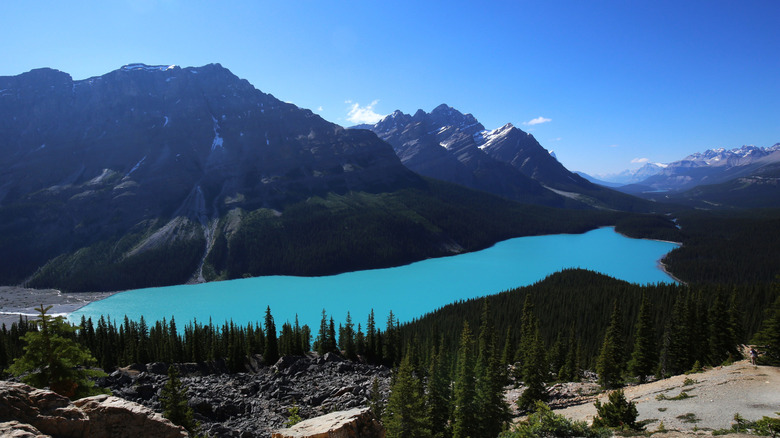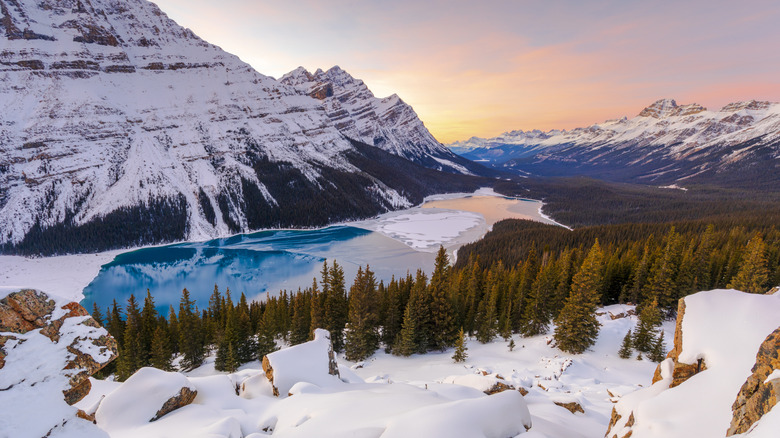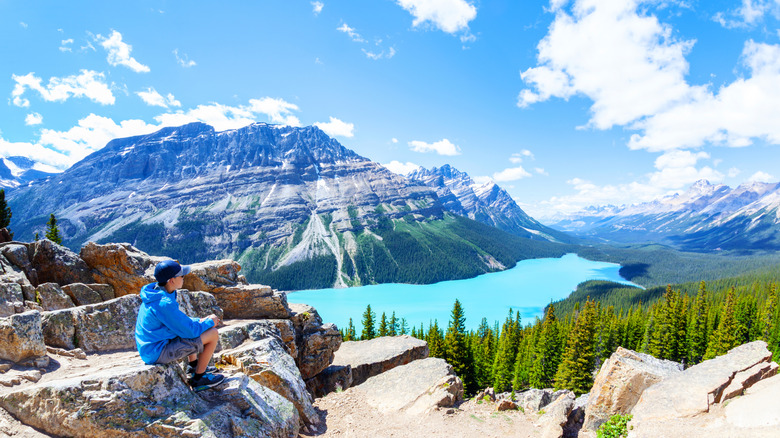Nestled In Banff National Park Is A Jewel-Toned Lake That Is A Picture-Worthy Vacation Destination
Most of the world knows Banff, situated in the heart of the Canadian Rockies, as a national park full of majestic mountains and vibrant blue waters. After all, Lake Louise is an international icon, and many could also recognize her neighbor, Moraine Lake, whose turquoise waters make it "Canada's most beautiful lake." However, unless you've been there, you may not yet have heard of the slightly more northern Peyto Lake. Conveniently cradled between Caldron Peak and the Icefields Parkway that stretches between Banff and Jasper National Park, this body of water is unique not just for its blue-topaz hue but also for its shape, which looks like the head of a wolf at one end.
Peyto's got some of the clearest water in the world thanks to glacial runoff. And with its prime location right by the roadside, it's an easy spot to snap a selfie without a crowd of tourists around. If you're passing by in late spring or summer, when the lake's turquoise hue is at its peak, it's a good time to stop at Peyto Lake Upper Viewpoint — a great spot to stretch your legs on your Rocky Mountain drive.
The secret behind Peyto Lake's brilliant blue waters
Peyto Lake is one of North America's most unbelievably vibrant blue bodies of water. But why and how? Like most of Banff's hyper-blue beauties, Peyto Lake is fed by glacial runoff — or melting waters rich in mineral-infused sediment. The "glacial flour" (or silt) that feeds the lake comes from the Wapta Icefield — specifically from Peyto Glacier, which rests below Peyto Peak — as a result of its freeze-thaw cycle every year. When the glacier freezes, it sticks to the mountain, chafing the bedrock with its icy edges and removing particles fine as sand grains from the surface. Then, each time the weather warms and the glacier melts again, the water carries this super-light, particulate matter to the lake waiting below.
The blueness seen by an observer is a result of sunlight reflecting on the water's surface, when the glacial flour floats up close to the top and creates a barrier that prevents light from hitting anything below the surface. This ultimately makes the color appear murkier, too. Ultimately, more flour there is in a lake, the bluer it appears — and since Peyto Glacier has observed particularly high melt rates, Peyto Lake gets fed with even more of this light-catching substance than most.
This is especially apparent in bright sunlight during the summer, both due to the brighter skies and longer hours of light from a northern-angled sun. Plus, with increased runoff from the glacier due to melting, it creates the perfect recipe for Peyto Lake looking bluer than ever.
How to get there and where to stay nearby
Peyto Lake is located right off the Icefields Parkway (Highway 93), a route that links two of Canada's best national parks on a scenic road trip. If you're traveling between Banff and Jasper, a short stop here makes for a perfect moment to get out and stretch your legs. The viewpoint and parking lot are 62 miles north of the village of Banff. From there, it's another 116 miles to the city of Jasper.
For sightings, you can simply pull off at the roadside Peyto Lake Upper Viewpoint. But for the best vantage, the nearly 4-mile return hike to the top of Bow Summit (pictured above) will really bring out the blue color. Plus, you'll feel like a god staring down into the sharply curved mountain basin from on high! There's also the Peyto Lake Trail, which curves around the lake's eastern perimeter, offering the clearest imagery of the lake's wolf-head silhouette — a favorite of photographers and influencers. Just note that, although short at only 15 minutes one way, the hike is uphill and still requires appropriate footwear.
While most travelers passing Peyto will likely be on their way to the major resort towns, there are also several places for lodging within a 25-mile drive. The HI-Mosquito Creek Hostel and The Lodge at Bow Lake both have rustic comfort and historic charm, with the former being ideal for hikers and backpackers. Meanwhile, the Emerald Lake Lodge offers mid-range luxury and is pet-friendly, or you can find ultimate comfort and more picture-perfect views at the famed Fairmont Château Lake Louise. Finally, for camping, Waterfowl Lakes and Mosquito Creek are the two closest park campgrounds.


